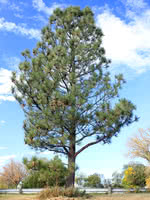Mon-Fri 9am - 5pm Mountain time
Ponderosa Pine vs Japanese Black Pine
Pinus ponderosa
Pinus thunbergii
NOT AVAILABLE THIS SEASON - MIGHT RETURN
Ponderosa Pine is the tallest known pine in North America. This popular evergreen has distinctive, textured bark and long needles.
This makes it an excellent ornamental tree for landscaping on large properties. Ponderosa Pine is hardy in a variety of soil conditions.
Japanese Black Pine is known for its unique and irregular growth habit, making it a striking landscape addition. It typically does not grow with a central leader. This causes it to form a flat-top, classic bonsai-like shape when mature. When it has a central leader, it will grow with a twisted trunk. Another striking feature is the white apical buds which contrast with the surrounding green needles.
The Japanese Black Pine is an excellent candidate for a bonsai tree and is frequently used by the bonsai community. It is found along the Japanese coast and is salt tolerant.

